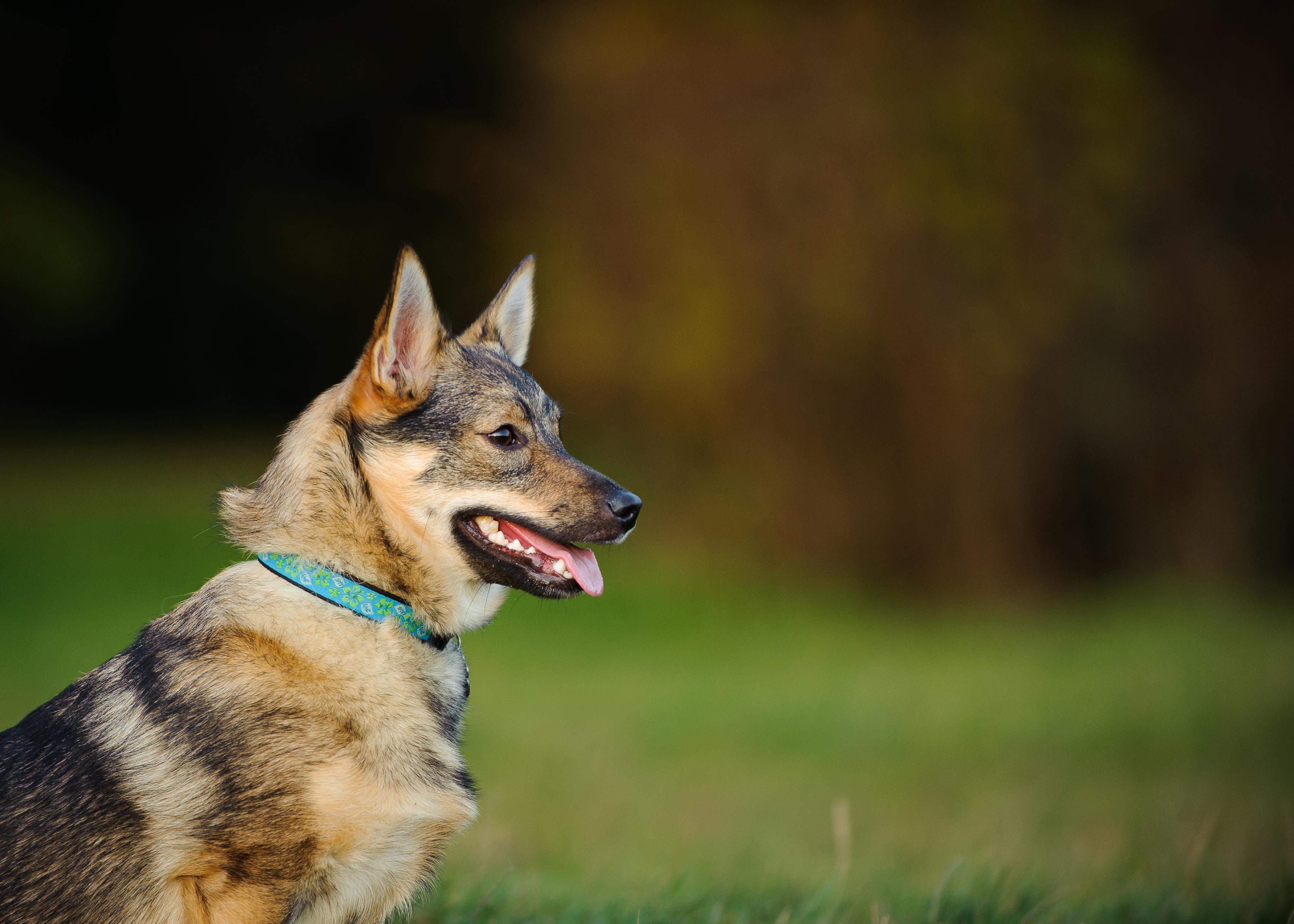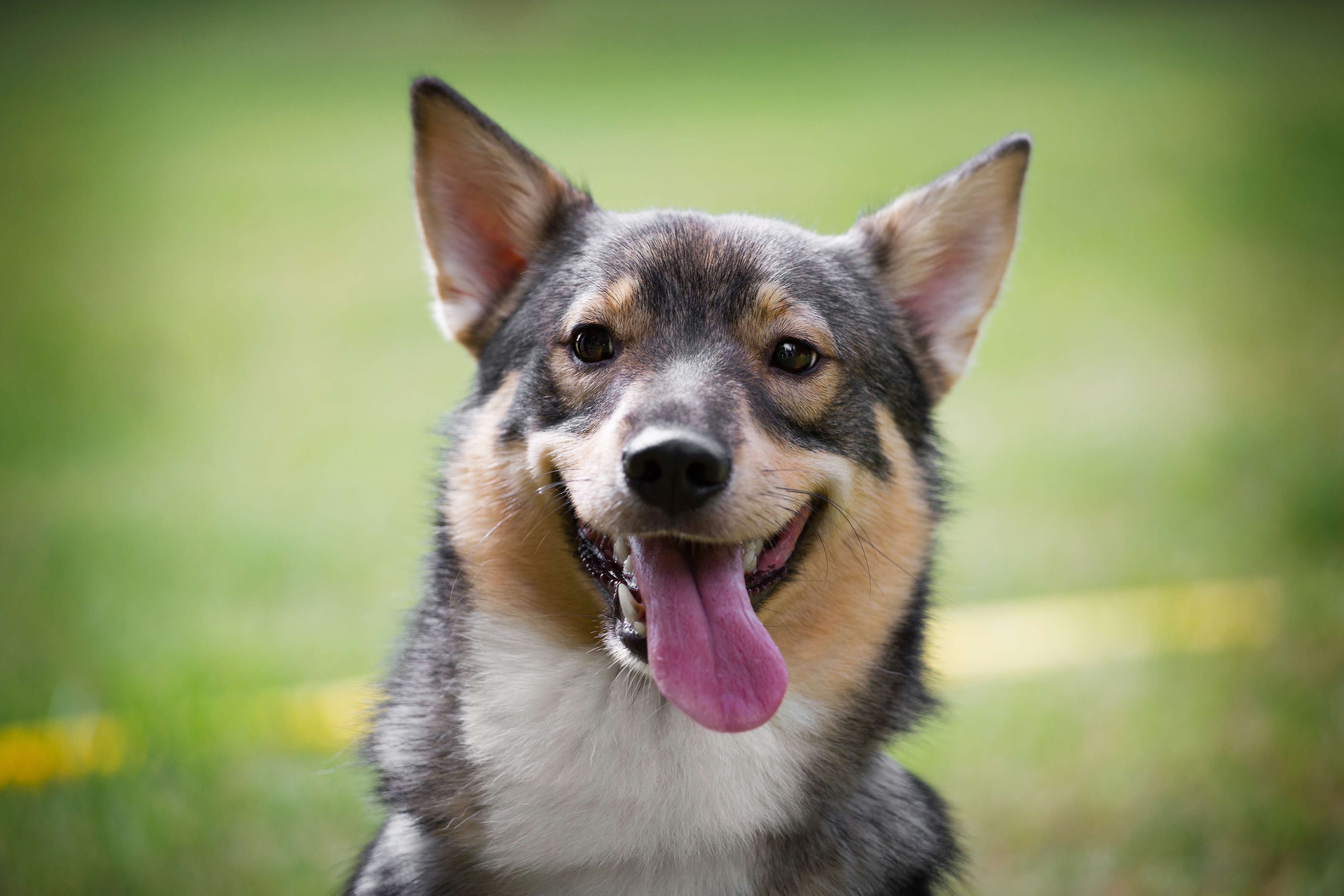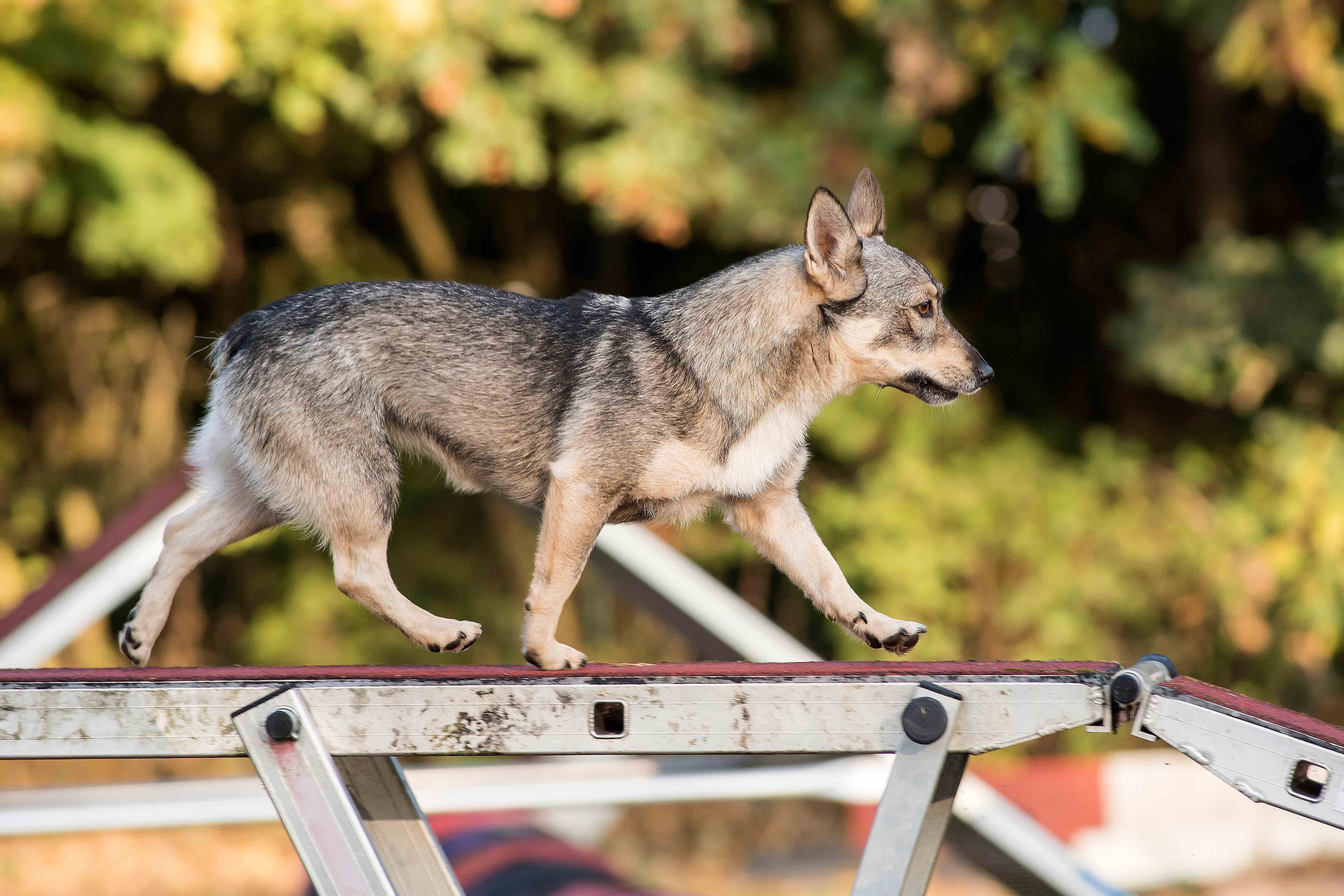Swedish Vallhund
Adobe Stock/cynoclub
The Swedish Vallhund is an affectionate and energetic dog that was originally bred to herd cattle on ranches and farms. According to the Swedish Vallhund Club of America (SVCA), these cute little herding dogs have been around since the Vikings, over 1,000 years ago.
The breed was recognized by the Swedish Kennel Club in 1943 but not recognized by the American Kennel Club until 2007. The breed has a long back and short legs, similar to the Pembroke Welsh Corgi and Cardigan Welsh Corgi. Full-grown Swedish Vallhunds stand 11–14 inches tall and typically weigh 20–35 pounds.
Caring for a Swedish Vallhund
Well-trained and socialized Swedish Vallhunds make wonderful family dogs. Most are patient with children who have been taught how to interact with smaller dogs. Some Swedish Vallhunds may, however, be reserved around new people and dogs, so slow introductions are crucial.
Swedish Vallhunds are smart dogs that are eager to please their people, which makes them easier to train than some breeds. They are a high-energy breed that requires a lot of physical activity and mental stimulation to stay out of trouble. Because of their history as a herding dog, they may try to herd children, so it’s up to you to teach your Swedish Vallhund that this isn’t appropriate.
Swedish Vallhund Health Issues

The Swedish Vallhund dog is generally a healthy breed without a lot of issues. But, like all dogs, there are a few health conditions pet parents should be conscious of.
In addition to these conditions, all dogs are at risk of injury and illness. Purchasing pet insurance for your dog may help pay for expensive medical needs.
Swedish Vallhund Retinopathy
Swedish Vallhunds can develop a hereditary form of progressive retinal atrophy (PRA) that is unique to their breed. In this condition, the photoreceptor cells of the retina (rods and cones) degenerate, leading to vision loss. Initially, the dog may have difficulty seeing in the dark, but over time complete blindness occurs.
There are no effective treatments, but there is a DNA test for the mutation found in Swedish Vallhunds. Reputable Swedish Vallhund breeders will not breed dogs with this mutation.
Cataracts
Cataracts occur more frequently in Swedish Vallhunds than in many other dog breeds. In most cases, the condition develops in older dogs as proteins and fibers in the lens of the eye break down, causing the lens to become cloudy. This leads to blurred vision, which can progress to blindness. This is an inherited condition in most cases, but cataracts can also be seen with diabetes mellitus or after an injury to the lens.
In some cases, cataracts cause inflammation and discomfort, requiring medication. There are no effective medications to slow their progression or prevent vision loss, but cataracts can be surgically removed by a board-certified veterinary ophthalmologist to restore vision.
Dental Disease
Dental disease is one of the most common conditions seen in dogs as they age, especially in smaller breeds. This occurs when bacterial tartar and plaque lead to inflammation of the tissues around the teeth—and eventually to tooth and bone decay.
The best way to prevent dental disease is with daily tooth brushing with a dog-specific toothpaste and doggy toothbrush. You can also give your dog dental chews or add a dental solution to their water dish.
Routine dental cleanings are recommended to evaluate the mouth, remove plaque and tartar, polish teeth to prevent future buildup, and treat or extract teeth that are significantly unhealthy. As with humans, dental disease can be a painful condition and may even affect organ health.
Hip Dysplasia
Hip dysplasia is a genetic disease characterized by a loose hip joint that causes the cartilage and bone to wear down. This can cause osteoarthritis to develop, and arthritis leads to pain, limping, and difficulty rising. Many vets recommend low-intensity exercise and joint supplements containing omega-3 fatty acids, glucosamine, and chondroitin for dogs diagnosed with hip dysplasia.
When pain is present, non-steroidal anti-inflammatory drugs (NSAIDs) are frequently prescribed to reduce inflammation and pain. If the pain from hip dysplasia cannot be managed, your vet may recommend surgery.
Patellar luxation
In dogs with patellar luxation, the kneecap slips out of its proper groove. This causes discomfort and, like hip dysplasia, can lead to arthritis. Many affected dogs will skip or “bunny hop” on three legs when the kneecap is out of place.
In some cases, the knee returns to proper alignment on its own. But sometimes supplements or anti-inflammatory medications are required. In severe cases, your veterinarian may recommend surgery.
What To Feed a Swedish Vallhund

Feeding a commercial kibble or wet food that meets the standards set by the Association of American Feed Control Officials (AAFCO) is a good way to make sure your Swedish Vallhund receives a complete and balanced diet.
Swedish Vallhund puppies should be fed a food formulated specifically for puppies or designated for all life stages. For adult dogs, your veterinarian may recommend a dental-focused diet to help prevent dental disease. Talk to your vet about choosing the best food for your dog.
How To Feed a Swedish Vallhund
Not only do Swedish Vallhunds puppies need to eat specially formulated food, but they should also be fed at least three meals a day on a consistent schedule to prevent low blood sugar levels (hypoglycemia). Adult dogs should be fed a measured amount twice a day. Try to feed your dog at the same time every day to establish a routine.
How Much Should You Feed a Swedish Vallhund?
A dog’s recommended caloric intake depends on their size, metabolism, neuter status, and activity level. The best way to determine how much to feed your dog is to talk with your veterinarian. The packaging on your AAFCO-compliant dog food will also provide portion guidance.
Maintaining a lean body and healthy weight is important for protecting a Swedish Vallhund’s joints, as they are prone to patellar luxation and hip dysplasia.
Nutritional Tips for Swedish Vallhunds
While an AAFCO-compliant dog food provides your Swedish Vallhund with essential nutrients, individuals may also benefit from the addition of omega-3 fatty acids (DHA/EPA) into their diet if your veterinarian recommends it.
Omega-3 fatty acids can be found in skin and joint supplements, fish oil, and even in some specially formulated dog foods. These fatty acids will act as natural anti-inflammatories that support the skin, coat, kidneys, joints, and heart.
Never give your dog a supplement without speaking to their vet first.
Behavior and Training Tips for Swedish Vallhunds
Swedish Vallhund Personality and Temperament

The Swedish Vallhund temperament is generally very affectionate. While all dogs and children should be supervised and taught how to interact with each other, most Swedish Vallhunds are patient and gentle with children when socialized as puppies.
These dogs love to play and have excess energy that requires a lot of physical and mental stimulation. If not worked physically and mentally, they may develop undesirable behaviors like excessive barking or being destructive. Scent walks around the neighborhood are a good way to keep their mind focused.
Swedish Vallhund Behavior
Some Swedish Vallhunds are reserved around new dogs or people they don't know. Slow introductions and early socialization are helpful to make your dog more confident and outgoing. Pet parents must begin socializing their Swedish Vallhund puppy early—ideally within their first 16 weeks of life. Puppy classes can help with socialization, and your vet can give you more tips.
They may be excessive barkers, which can be curbed somewhat with extensive exercise, training, and mental stimulation. Due to their history as a herding breed, Swedish Vallhund dogs may have a strong prey drive. This means they may chase after small animals, and they must be kept safely on a leash or inside a fenced space when outside.
Swedish Vallhund Training
Swedish Vallhunds are smart and eager to please their pet parents. This means they can pick up training cues easier than some other breeds. Like all dogs, they do best with reward-based positive training.
Because they have a lot of energy, training will involve expending some of that energy through games and exercise. Once basic commands are mastered, additional training in activities like agility or nose work will keep the Swedish Vallhund challenged, entertained, and out of trouble.
Fun Activities for Swedish Vallhunds
-
Scent walks
-
Nose work
-
Obedience training
Swedish Vallhund Grooming Guide

Swedish Vallhunds have a coat that’s short and dense. They are heavy shedders that benefit from regular brushing, but they don’t require extensive grooming. In the spring and fall, they will have a heavy shedding period that can lead to huge piles of hair.
Skin Care
Swedish Vallhunds do not have special skin care needs. They should be bathed a few times per year or when overtly dirty. A gentle shampoo and conditioner for dogs is best.
Coat Care
Swedish Vallhunds have a double coat that sheds throughout the year, with two periods of extremely heavy shedding (in the spring and fall). Pet parents need to brush their Vallhund throughout the week to keep the fur under control and off the floor, with increased frequency during the spring and fall shedding seasons.
Eye Care
Swedish Vallhunds do not have special eye care grooming requirements. If debris collects in the corner of their eyes, this can be gently wiped off with a damp cloth. Visit the vet if you notice changes in your dog’s eyes, such as squinting, discharge, or redness.
Ear Care
Cleaning the ears every one or two weeks for maintenance helps prevent ear infections. Ask your veterinarian which dog-friendly ear cleaner they recommend. Consult a veterinarian if you see redness, odor, or debris, as these may be signs of an infection.
Considerations for Pet Parents
Swedish Vallhunds are affectionate, highly energetic, and intelligent dogs that make good pets for active families. They need a lot of exercise and mental stimulation, so a family that is too busy to meet these needs may find the Swedish Vallhund can be destructive or bark to excess. They do well with most children if exposed early in life.
Swedish Vallhunds have a double coat that requires routine brushing to keep the hair from accumulating, but this breed does not require excessive trips to the groomer.
Swedish Vallhund FAQs
How much does a Swedish Vallhund cost?
Purchasing a Swedish Vallhund from a breeder can cost $1,000 to $2,000. There is also a rescue run by the breed club, where you can adopt a Swedish Vallhund.
Are Swedish Vallhunds good family dogs?
The Swedish Vallhund can make a great pet for an active family. Most are patient with children, especially if the children and the dogs are taught how to interact with each other at a young age. Swedish Vallhunds have high energy needs, so they do best with a family that likes to get outside, take walks, and play often.
Is a Swedish Vallhund a Corgi?
No. While both Swedish Vallhunds and Corgis have short legs and long backs, the two are separate breeds.
Are Swedish Vallhunds rare?
Swedish Vallhunds are uncommon outside of Sweden but have become more popular internationally over recent years.
